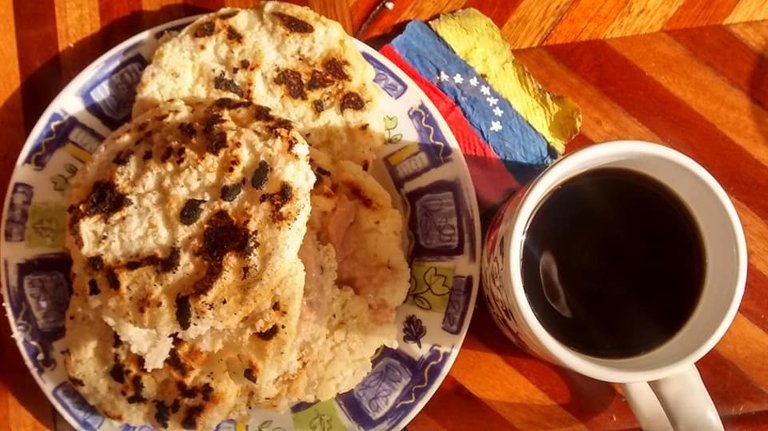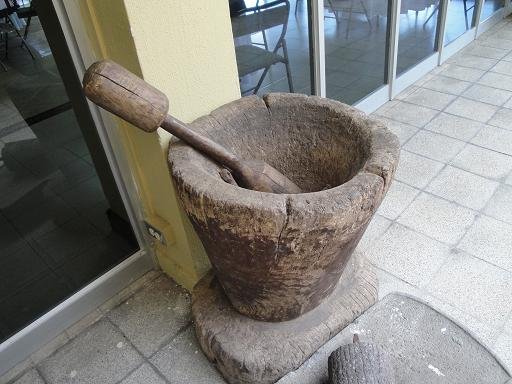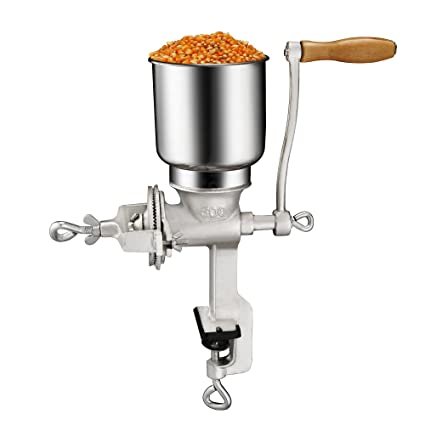
Own Source.
The Cornmeal Arepa (made from maize or corn) is the oldest recipe for arepas. Initially the natives grinded the corn with stones and once they get the corn grinded, they cooked it in clay dishes. With the time they developed the "Pilón", which is basically a wooden log with a carved cavity in which you would insert the ingredient (corn) so you could grind it with a wooden mace. So basically the "Pilón" is just a big grinder


Source: http://www.sanramoncr.com/?p=203
The first thing to do is to grind the corn, this means we need to take the corn's shell out. Try this, take the corn grain out of a tender cob and cook it, you will realize it shreds its own shell by itself, this is the shell responsible for avoiding that you can get the dough just by mashing the corn, There comes the "Pilón", which will help you to give consistent hits to the corn so that the shell is removed and there you go, you got your grinded corn ready to be cooked.
Here is a video that shows how people used the grinder to make the dough:
Nowadays there are other tools that make the job easier and helps on getting big quantities of corn done, these are grinders that achieve moderate RPM(Revolutions Per Minute), this way they can get the shell out of the corn much faster, easily and more importantly, getting a clean product, these grinders are likely to be fueled by electricity or gas.
In these two videos we can see some examples of grinding machines
The most important thing to note is that in the industrial procedures you should not waste material, this means that the ingredients that are not fit for human are used to feed animals.
Generally, i buy just one kilogram of Grinded Corn at the market, there are two kinds, yellow and white. While there a small difference on the taste which can easily be noticed, most people tend to buy the yellow corn (maybe just because it does not looks so pale), i could only say that the white corn is more like the "Harina P.A.N" Flour or the "Juana" flour too, which is commercial flour you could find at the super markets. Usually i try to have to variations on it so in one week i buy the white corn, and on the next i buy the other kind. As im living right now in Venezuela, this makes it easy to find the corn already grinded on the market which goes for arround 0,35 USD.


Own Source.
Once you got the corn's shell out, the next step is to wash the corn a bit, just washing and rinsing on a strainer will do, you repeat this until you get crystalline water from the strainer. Once the corn is completelly clean, you let it sit in water during the night (or at least 8 hours) this will help the corn grow a bit and make it easier to cook.
The next step is to put the corn in a pot with water to start cooking, this may take 1 hour, you could even use a pressure cooker (make sure you are following the correct procedure to avoid dangers), it is important to note that the corn can get even four times its original weight just by absorbing water, this should be considered if you are using the pressure cooker and should also be reminded when you cook the portions(we will come to that later), you will know the corn is ready when you touch the corn and it got so soft that it feels like a dough, you can see how it should look like on the next picture.
Yellow Corn.


own source.
White Corn.


Own Source.
As i mentioned before, do not waste anything, you can use the water in which you boiled the corn to make "Chicha de Maiz", which is a sweet beverage, you just use the strainer to take the water away from the corn and there you go, 2 products from just 1 procedure, to get the "Chicha de Maiz" made you just mix it with sugar, cinnamon and some vanilla essence, then you put it on the fridge and you can serve it once its cold.

Now to make the dough, the next part is about mashing the corn, this is best done using a mill and could take about 1 hour of work depending on the kind of mill(if you got an electric mill this could be done in couple minutes), some people (like me) just got a manual mill, which is composed by an Endless Screw connected to a lever, this drags the corn mashing it up against a pair of disks separated by barely some milimeters, the corn will get out of the disks as dough. The Clamp is the part which helps us as a support to avoid us from moving the mill while we are moving the lever, clamping the mill to a table or some fixed place/thing .
Example:


Original Source: https://www.amazon.com/Premium-Quality-Grinder-Wheat-Grains/dp/B000U5NZ4I
Tip: You can work the corn cold or warm, but its important to not take it out of the water until you are going to mill it, because the corn will get dry and will be harder to mill.
I will show you some pictures where my husband and i are working the corn as i explained before:














This is Ricardo @feuerbolt, my husband.


Once its the milling finished, you can mash the dough with some water and bit of salt to get a nice consistency and get the round familiar form. Once done, this dough is ready to get cooked on a pan or to be stored on the fridge, this dough will last up to 8 days on the fridge if its properly conditioned. Also, as i mentioned before, the corn gains a lot of weight from the water, but once the arepa is cooking, that water will boil slowly making the arepa lose a bit of mass, take this in consideration when you are putting the arepa on the pan.
Tip: I like the arepas with a bit of salt, i dont use sugar, but some people do, so its up to you if you want to add salt, sugar or even both..
Actually with the crisis we got here in Venezuela, we had to cook as we did so long ago, its a hard work, but it got its rewards.
- Economical rewards: In my country you can find a mill for arround 9 USD, and the corn arround 0,3 USD which will feed 2 persons with an average breakfast of 2 big arepas for 8 days. It's easy to find this corn when you compare it to the other alternatives which go for a really higher price (could get over 2 or 3 times the real price) on the black market as they arent available all the time on the supermarkets. It is the best alternative for those who dont get any kind of food help from the government.
- Healthyness rewards: Acording to the Dr. Klara Senior, an Anti-Aging and Aesthetical Specialist, the grinded corn dough is recommended due to its low gluten content and natural source which makes it very healthy. celíacas. More Information here (Spanish): http://www.eluniversal.com/noticias/estilo-vida/masa-maiz-pilado-tiene-mas-fibra-menos-indice-glucemico_640455
Here's a small video of a corn producer.
I will add some pictures of arepas i made with this dough:
Grinded Corn Arepa filled with Perico.




Grinded Corn Arepa filled with Tuna and Mayo.








I hope you liked my post.
Have a nice day.
Follow - Upvote - Resteem
Hi! I am a robot. I just upvoted you! I found similar content that readers might be interested in:
https://lifehacker.com/baby-corn-is-a-real-vegetable-you-can-grow-1797465528
I did never talked about baby corn in this post. So not even close. Also is not about "growing" its about cooking a typical recipe from my country, even so, most of the pictures are made by myself except some that i used just to illustrate (in which i give the source where i found them), so please check up your comparison.